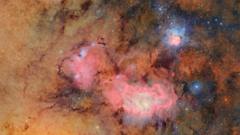In a striking turn of cosmic events, two black holes are currently drawing attention from astronomers and astrophysicists alike. As Halloween approaches, one black hole has gained the chilling label of a "serial killer," having recently set its sights on its second stellar victim within a five-year span. Meanwhile, researchers have identified what appears to be a groundbreaking configuration: a black-hole triple system that defies conventional astrophysical models.
The infamous black hole, often referred to as a killer, first made headlines with a bright flare emanating from a galaxy located 215 million light-years from our planet. This was identified as a “tidal disruption event” known by the designation AT1910qix, marking a cataclysmic interaction where a star strayed too close to the galaxy’s supermassive black hole. Over a period of five months, powerful gravitational forces tore the star apart, leaving a translucent ring of stellar remnants spiraling around the black hole. As half of its material spiraled into oblivion, the rest created a tempestuously expanding disc.
Now, researchers reveal that debris from this disc has drifted far enough to clash with another nearby star with alarming frequency. Approximately every two days, this star experiences a disruptive encounter with the residual matter, unleashing a burst of X-rays and high-energy emissions in a chaotic cosmic ballet.
A diverse team led by astrophysicist Matt Nicholl from Queen’s University in Belfast is utilizing advanced technologies, including the Chandra X-ray Observatory and the Hubble Space Telescope, to monitor these stellar interactions. Their recent findings, detailed in the journal Nature, shed light on the complex dynamics occurring in this region, pushing our understanding of black hole behaviors further than ever before.
In an equally fascinating development, the astronomical community eagerly examines the emergence of the first recognized black-hole triple system, presenting scenarios where three massive objects interact gravities in ways not previously predicted. As new data continues to pour in, the veil over the dark mysteries of black holes slowly begins to lift, offering a glimpse into the unimaginable forces shaping our universe.













